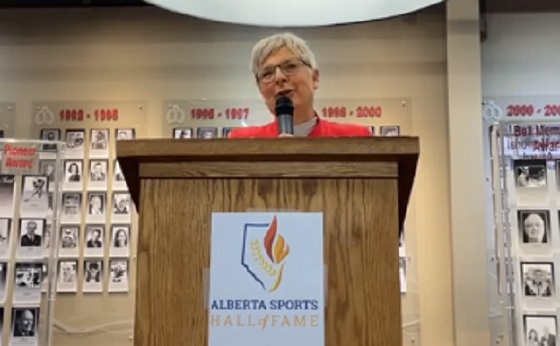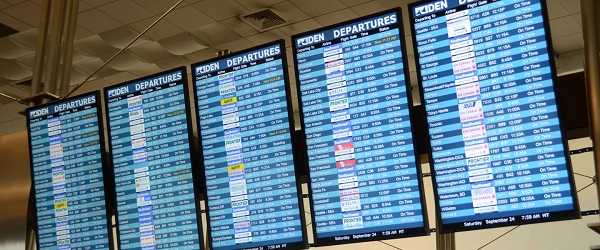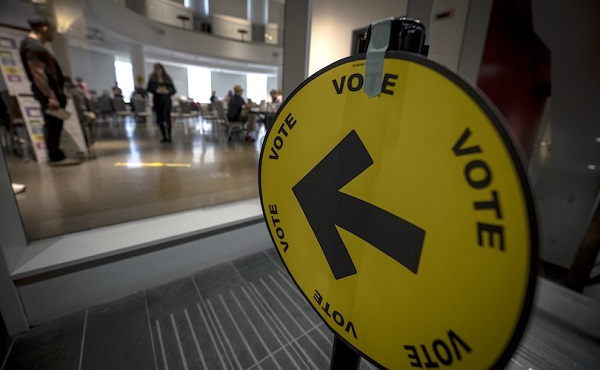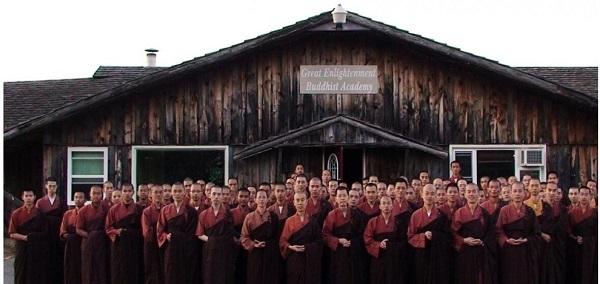Alberta
Alberta Sports Hall of Fame announces 2024 Inductees

Alberta Sports Hall of Fame Class of 2024
Shelley Vettese-Baert – Taekwondo Athlete
Born and raised in Edmonton, Shelley has left an indelible mark on the world of Taekwondo, boasting a remarkable 30-year career that has set her apart as a true pioneer in her sport. Her exceptional achievements include a World Cup bronze in Spain (1990), silver in Yugoslavia (1991), Olympic bronze in Spain (1992), gold at the Moscow and US Open in 1993, a bronze at the World Poomsae Championships in Russia (2011), and a bronze in Bali, Indonesia (2013). Recognized with the Governor General’s Jubilee Medal, she stands as Alberta’s only female athlete to reach such heights in Taekwondo. Beyond her achievements, Shelley is appreciated for her community impact, serving as a provincial and international coach and advocate in health and fitness. Retiring from Taekwondo sparring in 1999, she continues to participate in the “pattern” side of Taekwondo called Poomsae. To have reached the highest levels in both areas of Taekwondo (sparring and Poomsae) is a feat that few others have achieved. Shelley is also the first Taekwondo athlete to ever be inducted into the Alberta Sports Hall of Fame.
Chris McGregor – Horse Racing Athlete
Chris is a legendary figure in the world of horse racing. From 1979 to 2006 he participated in nearly 14,000 races and won 2,248 of them. A career high point came in 2000 when he won the Canadian Derby aboard Scotman, boasting an impressive 46% winning rate. McGregor’s excellence was recognized with nominations for the Sovereign Award in 1990 and 1992, along with notable wins such as Jockey of the Year in Saskatchewan in 1987 and Outstanding Jockey of the Year in 1988. He continued to be recognized for his winning talents by earning the Lou Davis Memorial Trophy for the top jockey in Alberta with 229 wins in 1990, as well as receiving the Joe Perlove Award for the most wins.
Darwin Davidiuk – Curling Builder
Darwin, a passionate advocate for curling, has been an integral part of the Alberta Curling community. He represented Northern Alberta’s interests at both provincial and national levels and coached successful Junior Men’s and Women’s teams in the 1960s-1970s. A competitive curler until 1990, Darwin won numerous zone berths and was a respected competitor known by many influential curlers. He founded the World Open, the first televised bonspiel on CBC, and is a founding member and current Vice President of the Northern Alberta Curling Championship Society. Notable achievements include serving as Vice Chair for various editions of the Labatt Brier and Tim Hortons Brier, promoting the Ford Men’s World Curling Championship in 2007, and leading initiatives for the 2013 Brier to honour curling legends and championship athletes in Edmonton.
Darwin spearheaded a project to commemorate the 100th anniversary of the Northern Alberta Curling Association (NACA), which ceased to exist due to the amalgamation of regional curling associations in Alberta. Serving as Vice President of the NACCS, Darwin collaborated with Terry Jones over 18 months to create a book celebrating NACA’s history.
Julius Fodor – Handball Builder
Julius Fodor played a pivotal role in advancing team handball in Alberta from 1963 onwards. Initially coaching at several Edmonton high schools, he founded the “Edmonton Canucks,” which significantly contributed to the sport’s future success in the province. Over the following years, Fodor played a vital role in introducing handball to prominent events such as the Alberta Winter Games and the Western Canada Games, and in developing the Canadian Team Handball Federation. Starting in 1968, he both played and coached teams at the international level, actively participating in organizing the 1978 North American Championships. Fodor’s extensive involvement in handball, spanning local, provincial, national, and international levels from the 1960s to the early 2000s, defines his lasting legacy in the sport. Anyone who has played handball in western Canada owes a debt of gratitude to Julius, acknowledging him as a pioneering force in introducing and fostering the sport in the region.
Ken Hitchcock – Hockey Builder
Ken Hitchcock was born with a connection to the rink, spending a significant portion of his life in Alberta and the rest wherever he was needed as a coach and ambassador of the game of hockey. With over 50 years dedicated to shaping the sport, Hitchcock’s impact extends far beyond coaching excellence. His legacy is one of tireless commitment to building the game of hockey and uplifting those involved at every level. Hitchcock has contributed to hockey development in Alberta, Canada, and around the world. His journey includes not just coaching but also helping hockey grow in Indigenous communities in our province and organizing coaching clinics in countries like France, Norway, and Germany. His dedication to hockey’s growth and empowering those involved shines through in his remarkable career.
Patrick Jarvis – Paralympic Builder
Patrick Jarvis has dedicated his life to empowering people with disabilities and encouraging them to seek their full potential through sports. As an athlete and builder, he has provided leadership to the Canadian Paralympic community for several decades. He competed at the 1990 World Track and Field Championships, as well as in the 1992 Summer Paralympic Games. Following his retirement from competition, he turned his attention to team management. He volunteered his time to the Alberta and Canadian Amputee Sport Associations, as well as the Canadian and International Paralympic Committees. Through these and other roles, he has guided hundreds of Canadian para-athletes and transformed multiple sports organizations.
Clayton “Darrell” MacLachlan – Alpine Skiing Builder
Darrell MacLachlan swiftly gained recognition within the Alpine Skiing community for his exceptional knowledge, unwavering passion, and remarkable skills, particularly in his commitment to supporting athletes navigating the challenges of a highly competitive environment. His global impact became evident as he consistently advocated for athlete safety and strived to establish a fair and level playing field for all participants. Embracing an important role within the Federation of International Skiing (FIS), Darrell took on critical responsibilities within various Committees and Sub-Committees of the FIS, making invaluable contributions to the Canadian Snowsports Association (CSA), FIS, and the broader International Ski Community. Above all, Darrell exemplifies a readiness to listen, adapt, and learn, ensuring the transfer of knowledge to others in the pursuit of excellence in alpine skiing.
Theresa Maxwell – Volleyball Builder
Theresa stands as one of the foremost builders of volleyball in the Volleyball Canada community, leaving an indelible mark on the sport. A dominant female student-athlete at the University of Calgary in the 1960s, Theresa’s sports journey began as she earned the title of University Female Athlete of the Year in 1964 and 1966. She then went on to coach children and youth at all levels, from developmental to highly competitive. She seamlessly transitioned to the administrative side of sports, dedicating over a decade to the Board and Presidency of the Alberta Volleyball Association. Her focus was to provide participation opportunities for all by developing programs and support at whatever age and level they chose to compete. From 1990 to 1994, Theresa assumed the role of President with Volleyball Canada, making history as the first woman appointed to the World League Volleyball jury in 1995. Her leadership extended internationally as the Head of Delegation for various prestigious events, including the Women’s World Championship in 1993. Theresa’s enduring commitment and devotion to volleyball have been instrumental in fostering the sport’s growth at the local, provincial, and national levels.
Ozzie Sawicki – Paralympic Builder
Ozzie Sawicki’s enduring career in the realm of sports spans over three decades, marked by a steadfast commitment to inclusivity and the belief that sport should be accessible to individuals of all abilities. From 2000 to 2004, Ozzie served as the head coach for the Canadian Para-Alpine Race team, achieving remarkable success at the Salt Lake City Paralympic Games in 2002. As the head coach of the Canadian Para Alpine Ski Team, Ozzie played an important role in securing 12 out of the total 15 medals earned by Team Canada at those Games. His leadership extended to the position of Team Canada’s Chef de Mission for the Sochi 2014 Paralympic Winter Games, where Canada surpassed performance goals, securing seven gold, two silver, and seven bronze medals. Beyond his notable contributions on the international stage, including his role as head coach with the Canadian Para-Athletics Team (2009 to 2011) and as performance advisor to the Paralympic and Olympic Equestrian Teams (2009 to 2016), Ozzie is deeply involved in his community, earning recognition for his tireless efforts to enhance the world of adaptive sports and advocate for inclusivity and positive change.
Ron Thompson – Athletics Builder
For over four decades, Ron’s unwavering dedication to coaching has left a mark on the athletic landscape. His influence stretches beyond regional borders, encompassing the Edmonton community and various track clubs, where he has adeptly recruited and coached athletes. Among his notable successes is Marco Arop, the first Canadian male to win world gold in the 800m. Ron’s coaching legacy goes beyond individual achievements, as he has mentored several athletes to become esteemed coaches at national and international levels. Serving as a “team coach” at the University of Alberta and representing Team Alberta and Team Canada at national and international games, Ron consistently demonstrates a commitment to excellence. His impact isn’t confined to track and field; he has also made substantial contributions as a specialized sport performance trainer for athletes in football, rugby, soccer, basketball, and hockey, with nine players in the NHL. Throughout his extensive coaching career, Ron Thompson has been a beacon for the transformative power of sports in the lives of his proteges, shaping the Alberta sports community and leaving a positive impact that extends well beyond the world of athletics.
Tom Three Persons – Rodeo Pioneer
Tom Three Persons, a member of the Kainai Nation and a revered Siksikaitsitapi rodeo athlete and rancher, secured his legacy by winning the saddle bronc competition title at the inaugural Calgary Stampede in 1912. This victory, recognized as a world championship at the time, marked him as the only Canadian victor among the top rodeo athletes of that era. As an Indigenous athlete, Three Persons left a lasting mark on the history of the Calgary Stampede. Beyond his excellence in the arena, he played an important role as a builder in the sports of rodeo and horse racing in southern Alberta during the first half of the twentieth century. It is this lasting impact that positions Tom Three Persons as a Rodeo Pioneer in Alberta, a testament to his enduring contributions to the rich heritage of rodeo and horse racing in the region.
John Frederick Utendale – Hockey Pioneer
John Utendale, a pioneering force in hockey, cemented his legacy as one of the first Black players to sign an NHL contract when he joined the Detroit Red Wings in 1955. His impact extended beyond the rink as he became the first athletic director and hockey coach at NAIT in 1966. Utendale’s dedication to the sport reached new heights in 1980 when he earned an Olympic gold medal as the assistant training coach for the USA Men’s Hockey team. In 2023, he was recognized for his remarkable contributions by being honoured as a member of the induction class for the Alberta Hockey Hall of Fame. Utendale’s lifetime of barrier-breaking achievements was commemorated in 2022 through a House Bill by the Washington State Legislature, acknowledging his role as an athlete, educator, and civil rights trailblazer. Further accolades followed in 2022, as he was inducted into the Western Washington University Athletic Hall of Fame and received Black History Month recognition from both the Edmonton Oilers and the Seattle Kraken in 2023. Utendale’s multifaceted impact on the world of hockey and his unwavering commitment to breaking barriers continue to resonate across generations.Top of Form
Join us for our Induction Ceremony on May 24. More details to follow.
For more information, please contact Tracey Kinsella, Executive Director at 403-341-8614 or via email at [email protected]
Alberta
Poilievre poised for comeback in Alberta stronghold

This article supplied by Troy Media.
Byelection win in Battle River-Crowfoot looks inevitable for Poilievre
Conservative Party leader Pierre Poilievre unexpectedly lost his Ontario-based seat in the House of Commons in the federal election. He’s running in a byelection in a safe Conservative riding in a different province. While some of his opponents and critics are hoping that lightning will strike twice, they can safely put this pipe dream to rest.
Poilievre was first elected in 2004. He ran as a Conservative MP in the Nepean–Carleton riding against David Pratt, a two-term Liberal MP and then Minister of National Defence. It was predicted to be a close race, and that’s exactly what happened. The 25-year-old, who had previously been
involved in Reform Party and Canadian Alliance circles, worked hard in this riding. He established a strong ground game with new and existing grassroots support. He won the riding with 30,420 votes (45.7 per cent), while Pratt finished second with 26,684 votes (40.1 per cent).
The newly minted Conservative MP’s support in Nepean-Carleton expanded in the preceding elections. He won 54.7 per cent in 2006, followed by 55.84 per cent in 2008 and 54.45 per cent in 2011. When his old riding was recreated during the federal election redistribution in 2012, Poilievre shifted to the new riding of Carleton. It wasn’t quite as Conservative-leaning, which meant it would take more work to hang on to this seat.
The 2015 election was a tough battle for Poilievre, but he won 46.86 per cent versus Liberal candidate Chris Rodgers’s 43.74 per cent. He had an easier time against Rodgers in their 2019 rematch, winning 46.35 to 38.23 per cent. Poilievre nearly crossed the 50 per cent threshold in 2021, earning 49.9 per cent of the vote. He now seemed solidly entrenched in Carleton.
That’s what made Poilievre’s April 28 loss to lightly regarded Liberal candidate Bruce Fanjoy so surprising.
There were a few factors that likely contributed to this upset. The Ottawa region, where the Carleton riding is located, turned heavily against most Conservative candidates in this year’s election. Poilievre had to run a national campaign and couldn’t spend nearly as much time in his local riding as he had done in the past. The Longest Ballot Committee, which was established in 2021 to protest Canada’s first-past-the-post electoral system, flooded the ballot with independent candidates and muddied the political waters. And, as Fanjoy suggested in an April 29 interview with CBC Radio’s Ottawa Morning, the issue of U.S. President Donald Trump and his tariffs could have partially turned the tide.
So be it.
Poilievre wanted to continue in politics and remain Conservative leader. His next move was to find a new seat to run in a byelection. He needed to resolve this matter quickly so that he could return to the House of Commons.
When three-term Conservative MP Damien Kurek graciously decided to step aside from his seat in Battle River-Crowfoot on May 2, a unique opportunity had opened up. Would Prime Minister Mark Carney call a byelection? He told the media that “I will ensure that it happens as soon as possible… no games, nothing, straight.” To his credit, the PM kept his word. When Kurek officially resigned on June 17, Carney issued the byelection writ on June 30.
Battle River–Crowfoot is one of the safest Conservative ridings in Canada. There hasn’t been a close result since the rural Alberta riding was created in the aforementioned 2012 federal election redistribution. Kevin Sorenson won 80.91 per cent of the vote in 2015, while Kurek won 85.5 per cent, 71.3 per cent and 82.84 per cent in 2019, 2021 and 2025, respectively.
If you include results in other iterations of the riding—Acadia, Battle River, Battle River-Camrose, Camrose and Crowfoot—it’s been in the hands of a right-leaning politician for all but two years. The only time it changed was when former Progressive Conservative MP Jack Horner crossed the floor to the Liberals in 1977. He was then crushed in the 1979 election, earning only 18.2 per cent of the vote against Progressive Conservative candidate Arnold Malone’s 77.12 per cent. (Malone decisively beat Horner again in 1980, winning 76.61 to 15.53 per cent.)
Some political pundits and prognosticators may be hoping the Aug. 18 byelection will be closer than expected. Liberal candidate Darcy Spady, along with Independents Bonnie Critchley and Sarah Spanier and some smaller party candidates, are all attempting to beat Poilievre in a riding that he’s never represented. The independence movement that has encompassed Western Canada as of late goes right through this riding. The Longest Ballot Committee has targeted Battle River–Crowfoot in hopes of creating another Carleton-like upset, too. Don’t count on any of this happening, however.
338Canada, a respected Canadian-based political forecasting and commentary website, showed a massive Conservative lead of 80 per cent (with a possible uptick of up to six per cent) on July 13. The odds of a Conservative win in Battle River–Crowfoot are currently at 99 per cent.
Poilievre is firmly in the driver’s seat. While it obviously doesn’t matter what his margin of victory is in Battle River–Crowfoot, he would surely like to keep it close to Kurek’s most recent victory. This means he can’t rest on his laurels—which isn’t his style to begin with—and has to take it to the finish line.
That’s exactly what he’s going to do.
Michael Taube is a political commentator, Troy Media syndicated columnist and former speechwriter for Prime Minister Stephen Harper. He holds a master’s degree in comparative politics from the London School of Economics, lending academic rigour to his political insights.
Troy Media empowers Canadian community news outlets by providing independent, insightful analysis and commentary. Our mission is to support local media in helping Canadians stay informed and engaged by delivering reliable content that strengthens community connections and deepens understanding across the country.
Alberta
Upgrades at Port of Churchill spark ambitions for nation-building Arctic exports

In August 2024, a shipment of zinc concentrate departed from the Port of Churchill — marking the port’s first export of critical minerals in over two decades. Photo courtesy Arctic Gateway Group
From the Canadian Energy Centre
By Will Gibson
‘Churchill presents huge opportunities when it comes to mining, agriculture and energy’
When flooding in northern Manitoba washed out the rail line connecting the Town of Churchill to the rest of the country in May 2017, it cast serious questions about the future of the community of 900 people on the shores of Hudson Bay.
Eight years later, the provincial and federal governments have invested in Churchill as a crucial nation-building corridor opportunity to get resources from the Prairies to markets in Europe, Africa and South America.
Direct links to ocean and rail

Aerial view of the Hudson Bay Railway that connects to the Port of Churchill. Photo courtesy Arctic Gateway Group
The Port of Churchill is unique in North America.
Built in the 1920s for summer shipments of grain, it’s the continent’s only deepwater seaport with direct access to the Arctic Ocean and a direct link to the continental rail network, through the Hudson Bay Railway.
The port has four berths and is capable of handling large vessels. Having spent the past seven years upgrading both the rail line and the port, its owners are ready to expand shipping.
“After investing a lot to improve infrastructure that was neglected for decades, we see the possibilities and opportunities for commodities to come through Churchill whether that is critical minerals, grain, potash or energy,” said Chris Avery, CEO of the Arctic Gateway Group (AGG), a partnership of 29 First Nations and 12 remote northern Manitoba communities that owns the port and rail line.
“We are pleased to be in the conversation for these nation-building projects.”
In May, Canada’s Western premiers called for the Prime Minister’s full support for the development of an economic corridor connecting ports on the northwest coast and Hudson’s Bay, ultimately reaching Grays Bay, Nunavut.
Investments in Port of Churchill upgrades
AGG, which purchased the rail line and port from an American company in 2017, is not alone in the bullish view of Churchill’s future.
In February, Manitoba Premier Wab Kinew announced an investment of $36.4 million over two years in infrastructure projects at the port aimed at growing international trade.
“Churchill presents huge opportunities when it comes to mining, agriculture and energy,” Kinew said in a release.
“These new investments will build up Manitoba’s economic strength and open our province to new trading opportunities.”
In March, the federal government committed $175 million over five years to the project including $125 million to support the rail line and $50 million to develop the port.
“It’s important to point out that investing in Churchill was something that both the Liberal and Conservative parties agreed on during the federal election campaign,” said Avery, a British Columbian who worked in the airline industry for more than two decades before joining AGG.
Reduced travel time
The federal financial support helped AGG upgrade the rail line, repairing the 20 different locations where it was washed out by flooding in 2017.
Improvements included laying more than 1,600 rail cars worth of ballast rock for stabilization and drainage, installing almost 120,000 new railway ties and undertaking major bridge crossing rehabilitations and switch upgrades.
The result has seen travel time by rail reduced by three hours — or about 10 per cent — between The Pas and Churchill.
AGG also built a dedicated storage facility for critical minerals and other commodities at the port, the first new building in several decades.
Those improvements led to a milestone in August 2024, when a shipment of zinc concentrate was shipped from the port to Belgium. It was the first critical minerals shipment from Churchill in more than two decades.
The zinc concentrate was mined at Snow Lake, Manitoba, loaded on rail cars at The Pas and moved to Churchill. It’s a scenario Avery hopes to see repeated with other commodities from the Prairies.
Addressing Arctic challenges
The emergence of new technologies has helped AGG work around the challenges of melting permafrost under the rail line and ice in Hudson Bay, he said.
Real-time ground-penetrating radar and LiDAR data from sensors attached to locomotives can identify potential problems, while regular drone flights scan the track, artificial intelligence mines the data for issues, and GPS provides exact locations for maintenance.
The group has worked with permafrost researchers from the University of Calgary, Université Laval and Royal Military College to better manage the challenge. “Some of these technologies, such as artificial intelligence and LiDAR, weren’t readily available five years ago, let alone two decades,” Avery said.
On the open water, AGG is working with researchers from the University of Manitoba to study sea ice and the change in sea lanes.
“Icebreakers would be a game-changer for our shipping operations and would allow year-round shipping in the short-term,” he said.
“Without icebreakers, the shipping season is currently about four and a half months of the year, from April to early November, but that is going to continue to increase in the coming decades.”
Interest from potential shippers, including energy producers, has grown since last year’s election in the United States, Avery said.
“We’re going to continue to work closely with all levels of government to get Canada’s products to markets around the world. That’s building our nation. That’s why we are excited for the future.”
-

 Energy2 days ago
Energy2 days agoIs The Carney Government Making Canadian Energy More “Investible”?
-

 Business2 days ago
Business2 days agoCompetition Bureau is right—Canada should open up competition in the air
-

 Immigration2 days ago
Immigration2 days agoUnregulated medical procedures? Price Edward Islanders Want Answers After Finding Biomedical Waste From PRC-Linked Monasteries
-

 Business1 day ago
Business1 day agoDemocracy Watchdog Says PM Carney’s “Ethics Screen” Actually “Hides His Participation” In Conflicted Investments
-

 Business2 days ago
Business2 days agoIt’s Time To End Canada’s Protectionist Supply Management Regime
-

 COVID-192 days ago
COVID-192 days agoFreedom Convoy leaders’ sentencing hearing to begin July 23 with verdict due in August
-

 National1 day ago
National1 day agoLiberals push to lower voting age to 16 in federal elections
-

 Bruce Dowbiggin16 hours ago
Bruce Dowbiggin16 hours agoHow Did PEI Become A Forward Branch Plant For Xi’s China?










